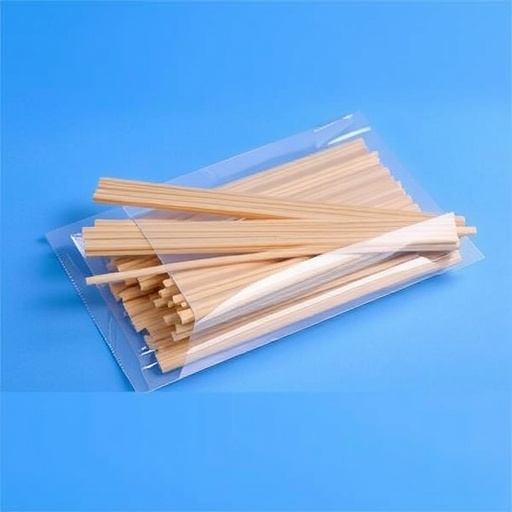In a groundbreaking study poised to transform food preservation techniques, scientists have demonstrated that vacuum packaging using polyamide/polyethylene (PA/PE) films significantly enhances the shelf life of hawthorn (Crataegus pinnatifida Bunge) sticks by both reducing microbial contamination and preserving critical physicochemical qualities during storage. This advancement holds tremendous promise for extending the usability of fragile fruit products, ensuring food safety, and reducing post-harvest losses in a world increasingly concerned with sustainable food consumption.
The research, conducted by a team led by Huang, Liu, and Tan, meticulously evaluated how vacuum packaging impacts hawthorn sticks—an increasingly popular snack and medicinal ingredient—over prolonged storage periods. Hawthorn, known for its rich antioxidant properties and health benefits, is particularly susceptible to rapid spoilage due to its high moisture content and biological composition. Conventional packaging methods often fall short in maintaining the textural integrity, flavor, and microbial safety of such perishable items, thus necessitating novel preservation strategies.
Central to their approach is the utilization of PA/PE composite films, which combine the excellent gas barrier properties of polyamide (PA) with the mechanical strength and flexibility of polyethylene (PE). This packaging matrix was hypothesized to not only inhibit oxygen ingress—a key factor in microbial proliferation and oxidative degradation—but also to maintain an anaerobic environment that further suppresses spoilage-causing organisms. The team embarked on comprehensive physicochemical and microbiological analyses to track the decline or preservation of hawthorn sticks’ quality indices throughout storage at chilled temperatures.
.adsslot_GJXHjsDQW1{ width:728px !important; height:90px !important; }
@media (max-width:1199px) { .adsslot_GJXHjsDQW1{ width:468px !important; height:60px !important; } }
@media (max-width:767px) { .adsslot_GJXHjsDQW1{ width:320px !important; height:50px !important; } }
ADVERTISEMENT
The physicochemical analyses corroborated these microbial findings. Moisture migration, a culprit of texture loss and microbial susceptibility, was minimized in vacuum packaging due to the films’ superior barrier properties. pH values in vacuum-packaged hawthorn sticks demonstrated greater stability, indicating limited organic acid breakdown and microbial metabolic activity. This biochemical steadiness maintains the desirable taste profile of the hawthorn sticks, which is pivotal for consumer acceptance and product differentiation in the competitive snack market.
Moreover, the titratable acidity levels—a key indicator of fruit freshness and fermentation status—were preserved at optimal values in the PA/PE vacuum group, unlike the atmospheric control where acid degradation was evident. This preservation points to reduced enzymatic and microbial activity, underscoring the effectiveness of the vacuum environment in maintaining metabolic stasis. Total soluble solids, associated with sweetness and flavor intensity, were also better retained, enhancing the sensory appeal of the product over time.
The technological implications of this study reach beyond hawthorn sticks. The success of PA/PE vacuum packaging implies broad applicability in preserving other moisture-sensitive fruit and vegetable products susceptible to microbial spoilage and physicochemical degradation. From an industrial perspective, adopting vacuum packaging technologies can substantially reduce food waste, optimize supply chain logistics, and cater to consumer demands for fresh-like quality in ready-to-eat snacks.
An in-depth examination of the vacuum packaging process revealed that the elimination of residual oxygen within the package reduces oxidative reactions, which are often initiated by oxygen radicals that accelerate nutrient loss and spoilage. The PA layer’s molecular density curbs oxygen transmission rates to nearly negligible levels, providing a controlled environment where aerobic microbes struggle to thrive. Meanwhile, the PE layer contributes to durability and seal integrity, ensuring the vacuum state persists throughout the storage period without compromise.
The study also touched on the sustainability aspect inherent in the use of PA/PE films. While multilayer films traditionally raise concerns over recyclability, advances in biodegradable and recyclable film composites are bridging this gap. Incorporating vacuum packaging aligned with environmentally conscious packaging trends could provide a dual solution—enhanced food preservation combined with reduced environmental footprint, a synergy increasingly emphasized in food technology innovation.
Consumer safety emerges as a pivotal advantage in light of growing foodborne pathogen outbreaks connected to minimally processed snacks. The researchers emphasized that vacuum packaging does not rely on chemical preservatives, which can raise health concerns, but rather leverages physical barriers to inhibit spoilage. This natural preservation modality aligns well with current market trends favoring “clean label” products free from artificial additives, potentially increasing market appeal and consumer trust.
The intricacies of hawthorn physiology, including its phenolic content and enzymatic activity, were also discussed in relation to packaging effects. The vacuum environment appeared to stabilize phenolic compounds, known for their antioxidant capacities and therapeutic benefits, by mitigating oxidation and enzymatic browning. Retaining such bioactive compounds elevates the product’s functional food status, catering to the burgeoning demand for health-promoting snacks.
Further, the team analyzed textural properties such as firmness and chewiness, which directly influence consumer perception and acceptance. Vacuum packaging preserved these sensory attributes better than conventional packaging, likely due to reduced moisture loss and microbial softening. These factors contribute synergistically to an enhanced eating experience, suggesting that vacuum packaging may help hawthorn sticks gain a stronger foothold in both domestic and international snack markets.
Interestingly, the findings open avenues for further research exploring the synergies between vacuum packaging and other preservation techniques such as modified atmosphere packaging, natural antimicrobial coatings, or cold plasma treatment. Such combinations may amplify the shelf-life extension and safety outcomes beyond what vacuum packaging alone can achieve, crafting multifunctional preservation systems tailored for diverse food matrices.
This study’s comprehensive approach, merging microbiological, physicochemical, sensory, and industrial considerations, positions it as a landmark contribution to food science and packaging technology. It resonates profoundly with current imperatives to reduce food spoilage, minimize environmental impact, and deliver safe, nutritious, and enjoyable food products to consumers worldwide.
As the global demand for nutritious snacks rises, innovations like vacuum-packaged hawthorn sticks underscore the marriage of cutting-edge material science and food technology to fulfill future food security and quality challenges. The promise of safer, longer-lasting, and more flavorful fruit snacks not only benefits producers and retailers but ultimately empowers consumers with better food choices.
Subject of Research:
Preservation of hawthorn (Crataegus pinnatifida Bunge) sticks using vacuum packaging with polyamide/polyethylene (PA/PE) films to reduce microbial growth and physicochemical index losses during storage.
Article Title:
Vacuum packaging with PA/PE reduce the microbial level and physicochemical index losses of hawthorn (Crataegus pinnatifida Bunge) sticks during storage.
Article References:
Huang, S., Liu, Y., Tan, Q. et al. Vacuum packaging with PA/PE reduce the microbial level and physicochemical index losses of hawthorn (Crataegus pinnatifida Bunge) sticks during storage. Food Sci Biotechnol (2025). https://doi.org/10.1007/s10068-025-01929-5
Image Credits: AI Generated
DOI:
https://doi.org/10.1007/s10068-025-01929-5
Tags: antioxidant properties of hawthorncomposite films in food storageconventional vs novel packaging methodsextending fruit product usabilityfood preservation techniqueshawthorn sticks shelf lifemaintaining food safetyPA/PE packaging technologypost-harvest loss reductionreducing microbial contaminationsustainable food consumption solutionsvacuum packaging benefits






